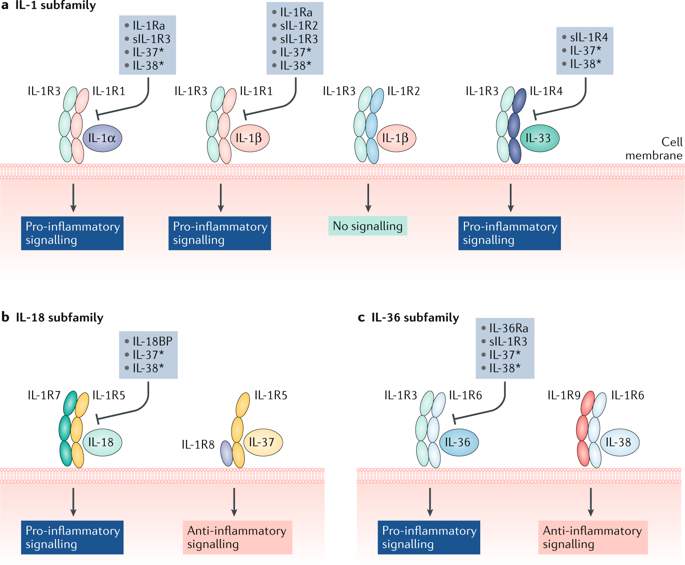当前位置:
X-MOL 学术
›
Nat. Rev. Rheumatol.
›
论文详情
Our official English website, www.x-mol.net, welcomes your
feedback! (Note: you will need to create a separate account there.)
The IL-1 family of cytokines and receptors in rheumatic diseases.
Nature Reviews Rheumatology ( IF 29.4 ) Pub Date : 2019-09-12 , DOI: 10.1038/s41584-019-0277-8 Charles Anthony Dinarello 1, 2
Nature Reviews Rheumatology ( IF 29.4 ) Pub Date : 2019-09-12 , DOI: 10.1038/s41584-019-0277-8 Charles Anthony Dinarello 1, 2
Affiliation

|
More than any other cytokine family, the 11 members of the IL-1 family are associated with innate immune responses, which occur in acute inflammation and chronic inflammatory conditions such as rheumatic diseases. In many rheumatic diseases, the severity of the condition can result from the balance between the pro-inflammatory and anti-inflammatory members of the IL-1 family. Pro-inflammatory family members (IL-1α, IL-1β, IL-18, IL-33, IL-36α, IL-36β and IL-36γ) are found in the articular environment during arthritis and often correlate with the degree of inflammation present. IL-1β has emerged as pivotal for promoting inflammation, particularly in autoinflammatory diseases, whereas IL-1α and the IL-36 subfamily are associated with skin diseases. IL-33 regulates T helper 2 (TH2) cell-mediated diseases, in sharp contrast to IL-18, which mainly regulates TH1 cell-mediated responses. The IL-1 family also contains four members that suppress inflammation: two specific receptor antagonists (IL-1 receptor antagonist (IL-1Ra) and IL-36 receptor antagonist (IL-36Ra)), and two members that broadly suppress innate inflammation by non-specifically reducing several cytokines and chemokines (IL-37 and IL-38). In this Review, each of the eleven IL-1 family cytokines and their receptors are discussed, along with their putative roles in rheumatic disease and therapeutic options for targeting or promoting these cytokines.
中文翻译:

风湿性疾病中的IL-1家族细胞因子和受体。
与其他任何细胞因子家族相比,IL-1家族的11个成员与先天免疫反应相关,后者在急性炎症和慢性炎症(如风湿性疾病)中发生。在许多风湿性疾病中,病情的严重性可能源于IL-1家族的促炎和抗炎成员之间的平衡。在关节炎期间,在关节环境中发现了促炎性家族成员(IL-1α,IL-1β,IL-18,IL-33,IL-36α,IL-36β和IL-36γ),并且通常与炎症程度相关当下。IL-1β已成为促进炎症的关键,尤其是在自身炎症性疾病中,而IL-1α和IL-36亚家族与皮肤疾病有关。IL-33调节T辅助2(TH2)细胞介导的疾病,与IL-18形成鲜明对比,它主要调节TH1细胞介导的反应。IL-1家族还包含四个抑制炎症的成员:两个特异性受体拮抗剂(IL-1受体拮抗剂(IL-1Ra)和IL-36受体拮抗剂(IL-36Ra)),以及两个成员通过以下方式广泛抑制先天性炎症:非特异性减少几种细胞因子和趋化因子(IL-37和IL-38)。在本综述中,讨论了11种IL-1家族细胞因子及其受体,以及它们在风湿性疾病中的假定作用以及靶向或促进这些细胞因子的治疗选择。和通过非特异性减少几种细胞因子和趋化因子广泛抑制先天性炎症的两个成员(IL-37和IL-38)。在本综述中,讨论了11种IL-1家族细胞因子及其受体,以及它们在风湿性疾病中的假定作用以及靶向或促进这些细胞因子的治疗选择。和通过非特异性减少几种细胞因子和趋化因子广泛抑制先天性炎症的两个成员(IL-37和IL-38)。在本综述中,讨论了11种IL-1家族细胞因子及其受体,以及它们在风湿性疾病中的假定作用以及靶向或促进这些细胞因子的治疗选择。
更新日期:2019-09-12
中文翻译:

风湿性疾病中的IL-1家族细胞因子和受体。
与其他任何细胞因子家族相比,IL-1家族的11个成员与先天免疫反应相关,后者在急性炎症和慢性炎症(如风湿性疾病)中发生。在许多风湿性疾病中,病情的严重性可能源于IL-1家族的促炎和抗炎成员之间的平衡。在关节炎期间,在关节环境中发现了促炎性家族成员(IL-1α,IL-1β,IL-18,IL-33,IL-36α,IL-36β和IL-36γ),并且通常与炎症程度相关当下。IL-1β已成为促进炎症的关键,尤其是在自身炎症性疾病中,而IL-1α和IL-36亚家族与皮肤疾病有关。IL-33调节T辅助2(TH2)细胞介导的疾病,与IL-18形成鲜明对比,它主要调节TH1细胞介导的反应。IL-1家族还包含四个抑制炎症的成员:两个特异性受体拮抗剂(IL-1受体拮抗剂(IL-1Ra)和IL-36受体拮抗剂(IL-36Ra)),以及两个成员通过以下方式广泛抑制先天性炎症:非特异性减少几种细胞因子和趋化因子(IL-37和IL-38)。在本综述中,讨论了11种IL-1家族细胞因子及其受体,以及它们在风湿性疾病中的假定作用以及靶向或促进这些细胞因子的治疗选择。和通过非特异性减少几种细胞因子和趋化因子广泛抑制先天性炎症的两个成员(IL-37和IL-38)。在本综述中,讨论了11种IL-1家族细胞因子及其受体,以及它们在风湿性疾病中的假定作用以及靶向或促进这些细胞因子的治疗选择。和通过非特异性减少几种细胞因子和趋化因子广泛抑制先天性炎症的两个成员(IL-37和IL-38)。在本综述中,讨论了11种IL-1家族细胞因子及其受体,以及它们在风湿性疾病中的假定作用以及靶向或促进这些细胞因子的治疗选择。











































 京公网安备 11010802027423号
京公网安备 11010802027423号